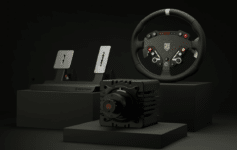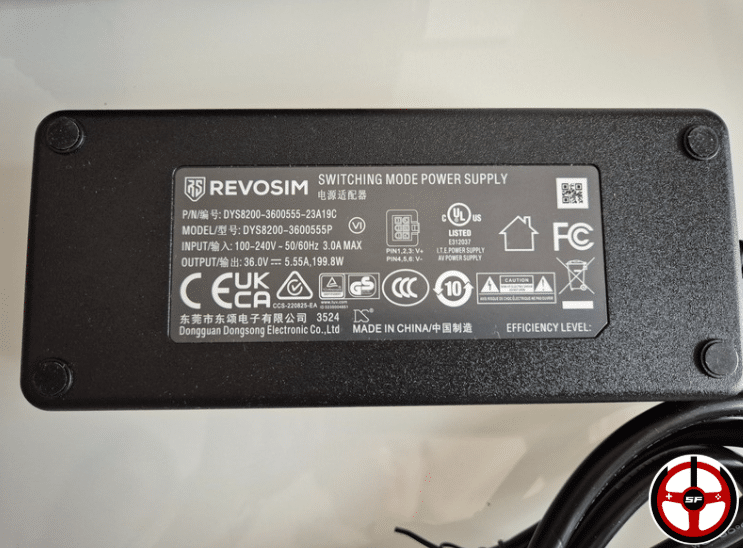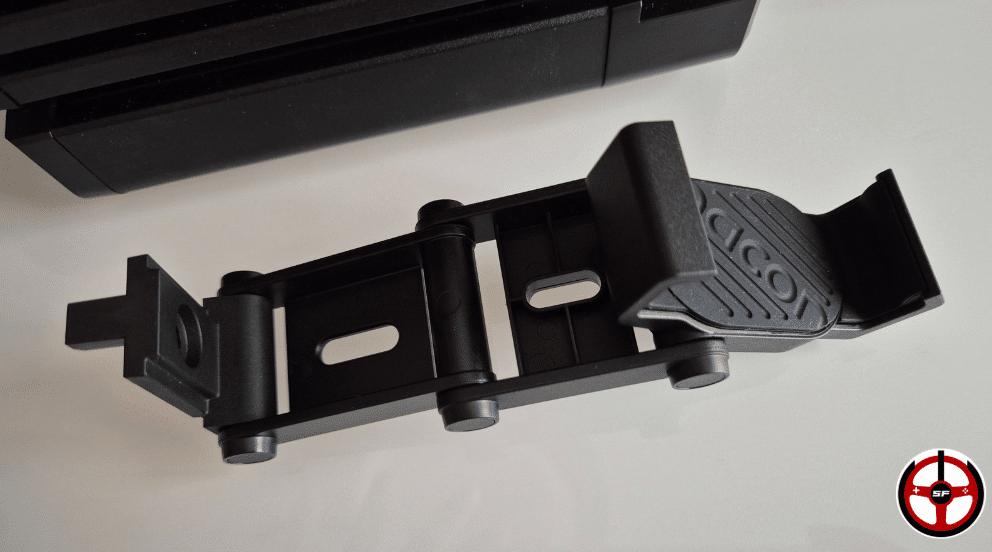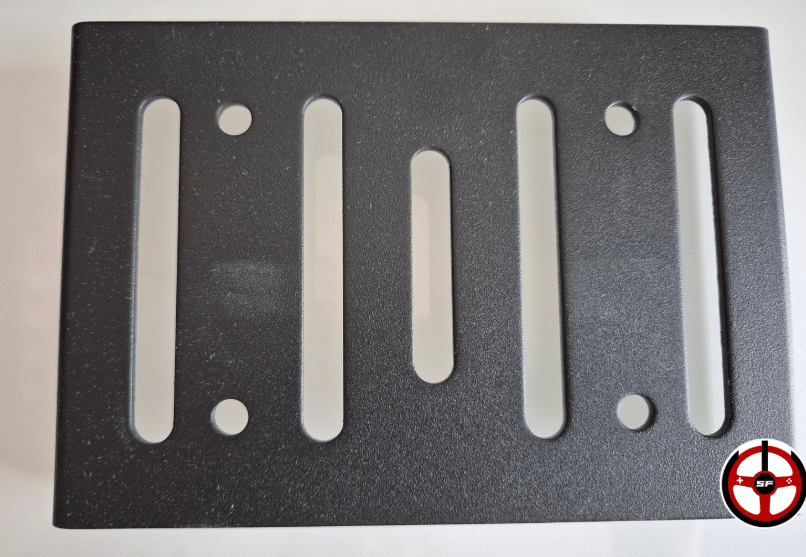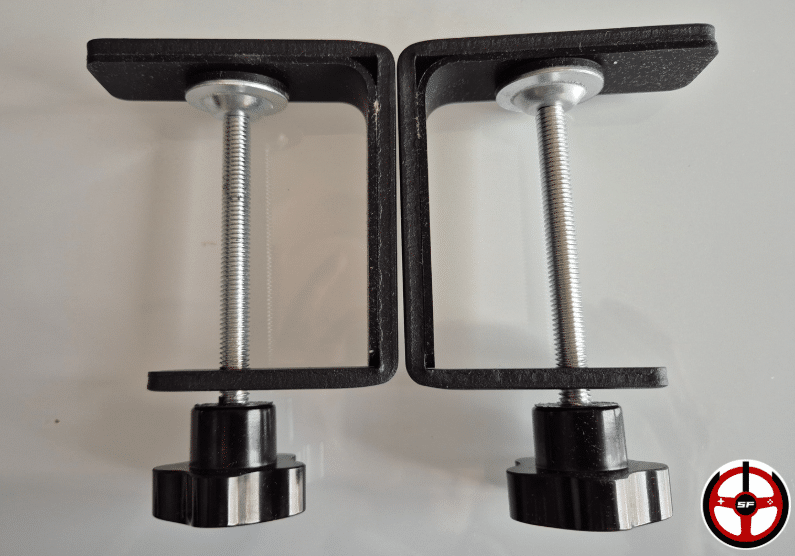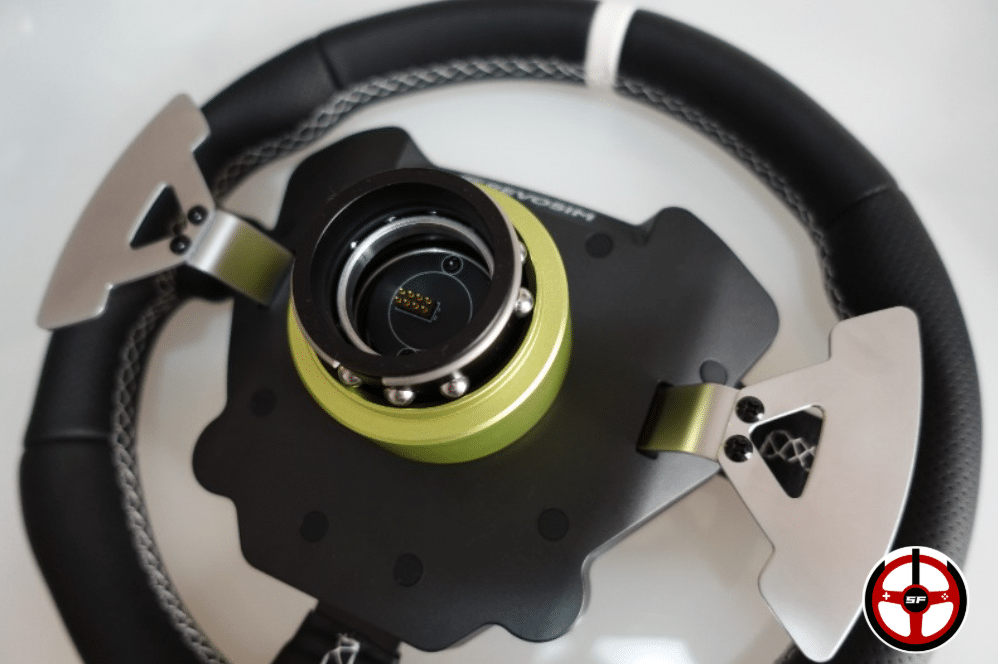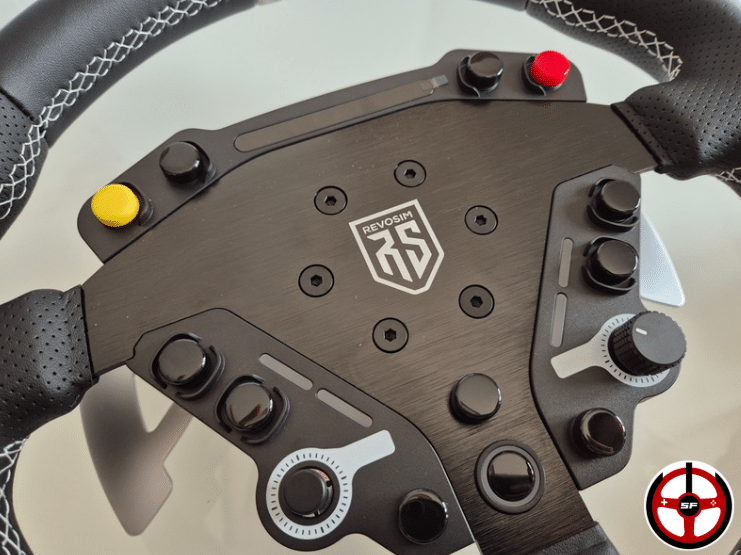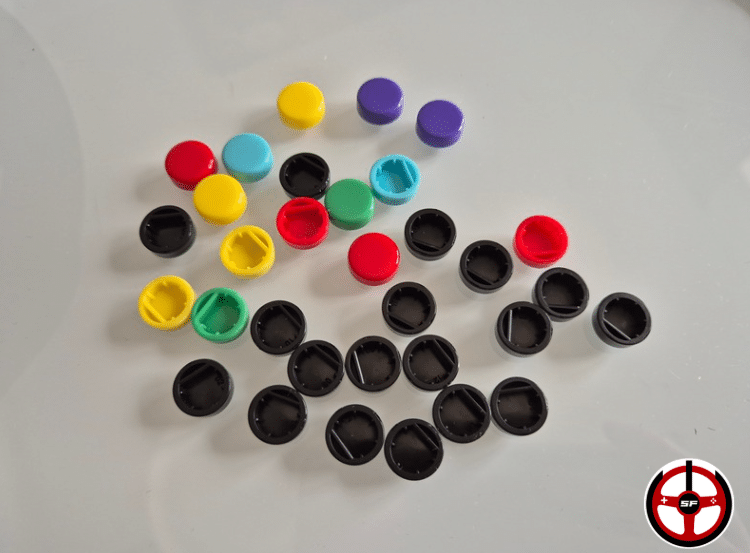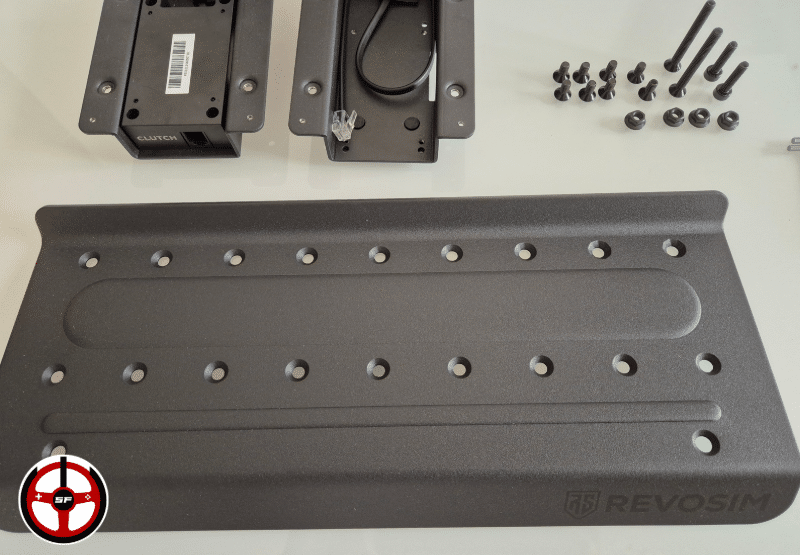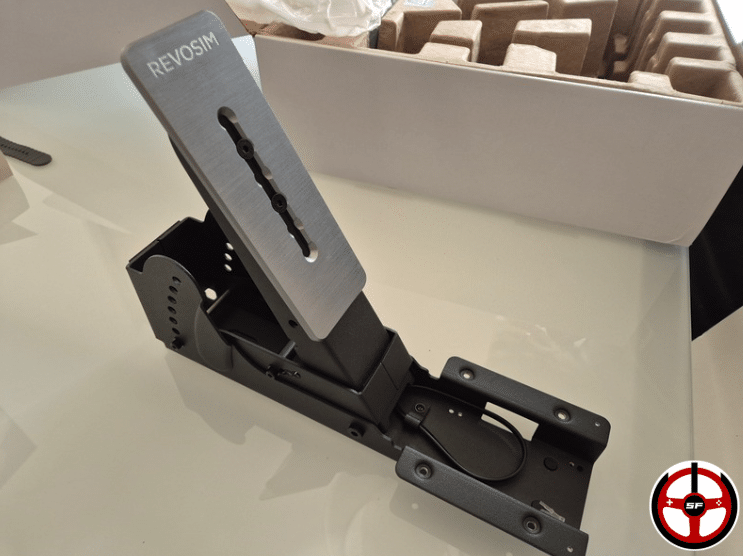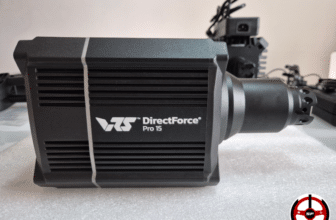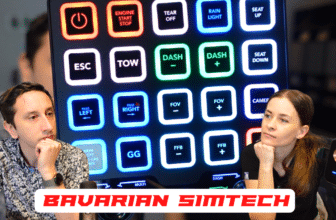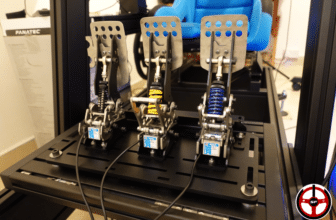
Here, at last, is the test of the Revosim RS Pure steering wheel, the simracing bundle from Revosim by Nacon. We had been closely following the creation of this model by visiting the offices of Nacon (Revosim’s parent company) a year ago, which enabled me to test their hardware on two occasions last April and May. This first Revosim racing wheel, PC-compatible only, is offered as a bundle from €699.90, and looks set to overshadow the Fanatec CSL DD 8Nm and Moza R9 in terms of both price and performance. But what does it actually do? Let’s find out!
Prices and deliveries
Design and ergonomics
In the complete bundle box:
- RS Pure base,
- RS Pure steering wheel,
- RS Pure Load Cell pedalset,
- Base stand and table clamps,
- 1 200W power supply and cord,
- 1 USB-C USB-A cable,
- RJ45 cable for connecting pedalboard to base,
- Torx wrenches, screws and T-nuts,
- Phone holder,
- Instructions for use.
Direct Drive RS Pure base
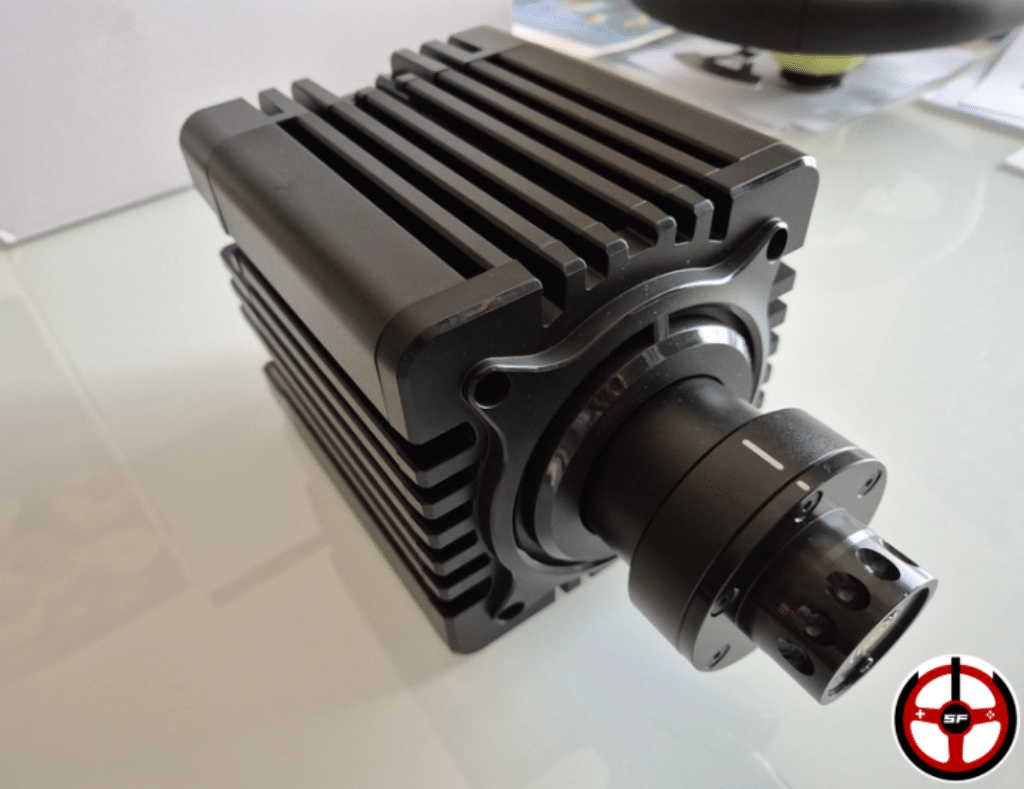
| Compatibility | PC (console compatibility has not yet been officially announced, but… It doesn’t take a rocket scientist to figure out that it’s coming) |
| Dimensions | Depth excluding QR 18.5cm, Space between steering wheel and base for screen: approx. 5cm, Width 14.5cm, Height 14.5cm, |
| Motor | Direct Drive – Brushless Servo Motor RevoSim |
| Torque | Peak: 9Nm Constant : NC Slew Rate : NC |
| Encoder | 21 bits (2,097,152 points per wheel revolution) |
| Turning range | 180 to 1600° Software-defined |
| Connections | USB-C output to PC, Power supply socket, Shifer connection, Handbrake connection, Pedalset socket. |
| Wheel mounting | NRG-type Quick Release |
| Price for wheelbase only | 549,90€ |
Design and ergonomics
From the outset, it’s easy to see where the inspiration comes from. The aluminum case recalls the design of the Fanatec CSL DD/GT DD Pro, with its heat-dissipating vents. The front and rear panels are made of plastic, and on the front there’s an LED just above the QR that indicates the base’s operating status.
The NRG-type Quick Release fits snugly and makes the flywheel/base junction without flexing. Turning the steering shaft by hand with the base off, I notice a little cogging. It’s less significant than on the CSL or R9 bases, but we’ll have to check that it’s perfectly eliminated once we’re on the track. The motor is a Revosim-designed Brushless Servo Motor capable of a peak torque of 9Nm, and equipped with a 21-bit encoder for precise force feedback.
A metaltable clamp is also supplied in the box, enabling the base to be installed on a tabletop up to 7cm thick. The clamp also allows the base to be tilted up to 15° to suit your riding position.
On the rear of the base
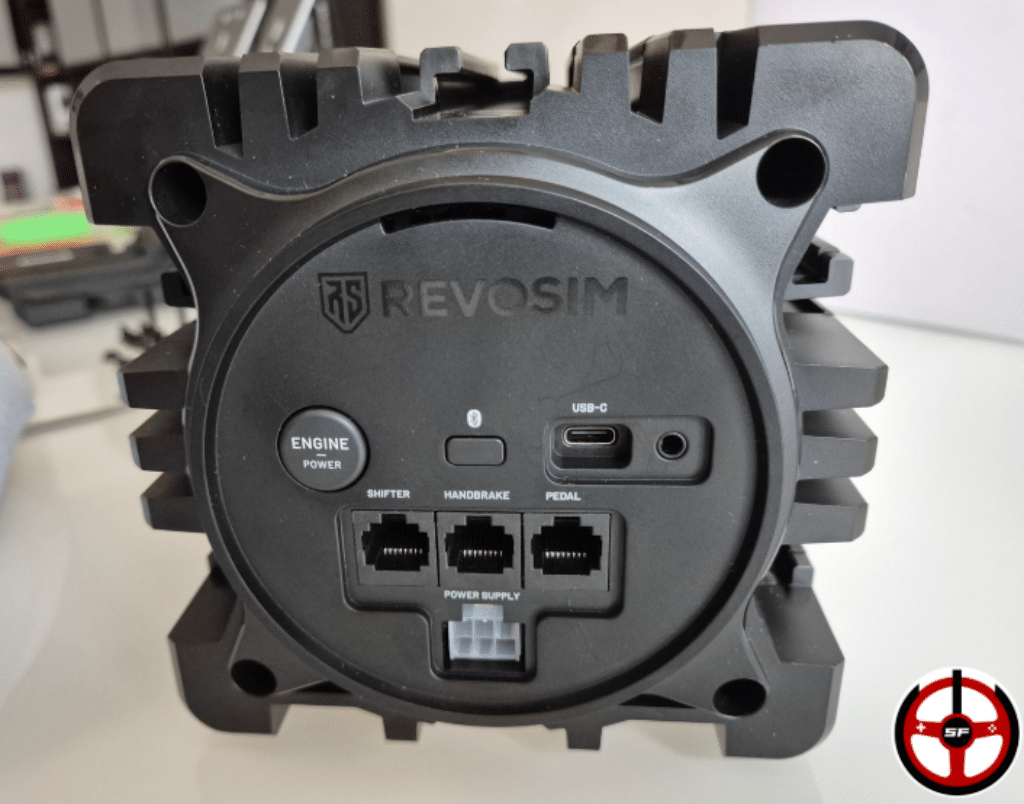
On the rear of the Revosim RS Pure, you’ll find the connectors for direct connection of a pedalset, shifter and handbrake. This confirms, if proof were needed, that the brand will soon be releasing a complete ecosystem. The USB-C socket for connecting the base to your PC, an ON/OFF button (press for 3 seconds to switch the base on or off) and a Bluetooth button for connecting your smartphone to the base, I’ll tell you more about the application below.
Installing the base on a chassis or desk
There’s something clear about Revosim’s approach: they want to appeal to a very wide audience. Whether you have a chassis or play on a desk, everything is taken care of. For installation, you have a choice:
- Use the 3 rails on the underside of the base and the T-nuts supplied (rails spaced 4cm apart across the width). In this case, you’ll be able to fine-tune the depth of your base for the best possible driving position.
- Use the 2 rails on each side of the base, again with T-nuts (rails spaced 7cm apart along the height).
- Use the depth-adjustable tilt bracket supplied with the base, which screws into the underside of the motor.
- And if you’re on a desk or table, use the tilting support with the two metal table clamps, also supplied in the box. These clamps are fitted with rubber pads for a firm grip on the table, and can be installed on tops up to 7cm thick.
Software, phone holder and in-house app!
Download our force feedback settings
In a few days, you’ll be able to download the force feedback settings I use on various games directly from the Nacon website. You can use them as a working basis to fine-tune and find YOUR ideal setting.
Link
On the software side, Revosim has worked hard to bring itself up to scratch, at least that’s how I felt the first time I saw the software dedicated to force feedback settings. It’s clear, simple enough and allows you to adjust everything quickly. You can create up to 4 different settings, which you can then load with a simple click on the rotary encoder at the bottom right of the steering wheel.

A smartphoneapplication is also available. It communicates via Blutooth with your base unit, allowing you not only to touch the settings, but also to use your smartphone as a dashboard. Now, you might say that you could also use SimHub to do this, but let’s face it, for novice gamers, this app will at least offer something plug and play.
But how do you install the phone on the base, you ask? It’s simple: Revosim supplies a phone holder with the base, which slides into the rail on top of the motor, or on the side if you prefer. But you can also screw the holder directly onto a chassis via the hole provided.
What’s it like on the track?
On games with FFB implemented, force feedback is straightforward, detailed and responsive. A few adjustments are all that’s needed to find the right balance between stable force feedback, without oscillations, but still detailed and informative.
If you cut all the force feedback filters completely, you’ll notice a hint of cogging. This disappears as soon as you pass 4-6% damper or friction, for example.
Overall, the base is very pleasant to ride. The effects are well managed and the feel natural. However, I would have appreciated a more direct bump stop. As it is, the stop is a little too soft, and once you’re on the track you may not notice that you’ve just passed the end of the steering angle by a few degrees.
On games without implementations, it was still tasteless and the fine details could really be improved. I’ll update my feelings when V1 is released.
Management of Direct Drive base heating
As always, our tests include a heating test. It always follows the same protocol to determine whether a base will be able to withstand long sessions. It’s a test that pushes the base to its extreme limit in the toughest conditions.
Closed, unventilated room.
Ambient temperature of 23.8°C.
FFB at maximum on the base and FFB in play at the saturation limit.
Standard test: minimum 100 laps in an Indycar on an oval until overheating or temperature stabilization.
I noticed a constant heating of the base during the first 45 minutes, without any impact on the deployed torque or fine details. Then, around 61°C in case temperature, I felt a slight drop in strength, but surprisingly, where normally I would have noticed some clipping that would have confirmed this drop, I still had my fine details well present. It wasn’t until the 75th minute, having reached a temperature of over 70°C, that I noticed the appearance of clipping, confirming a further drop in torque. The temperature then stabilized at between 73 and 74°C.
For a 9Nm base, the warm-up test should be taken into account! Chances are you’ll get roughly equivalent results if you’re doing endurance races, for example. So bear in mind that at full power, the motor may trigger a loss of torque to preserve its components. However, I appreciated the fact that the first torque drop (around 61°C) was very gradual and without loss of detail. So progressive, in fact, that I had to do the test twice to be convinced of the result…
The steering wheel delivered with the Revosim RS Pure bundle
Let’s move on to their first 30cm-diameter round steering wheel. Or should I say, their Hub equipped with a round hoop. Yes, it’s actually a hub with a 6x70mm center distance, on which you can install at least one other Formula-type hoop. But there’s one point to bear in mind. The Hub is “hollowed out” to fit the steering wheel spokes and give a smooth, “well-integrated” appearance. As a result, only Revosim hoops can be installed on this model.
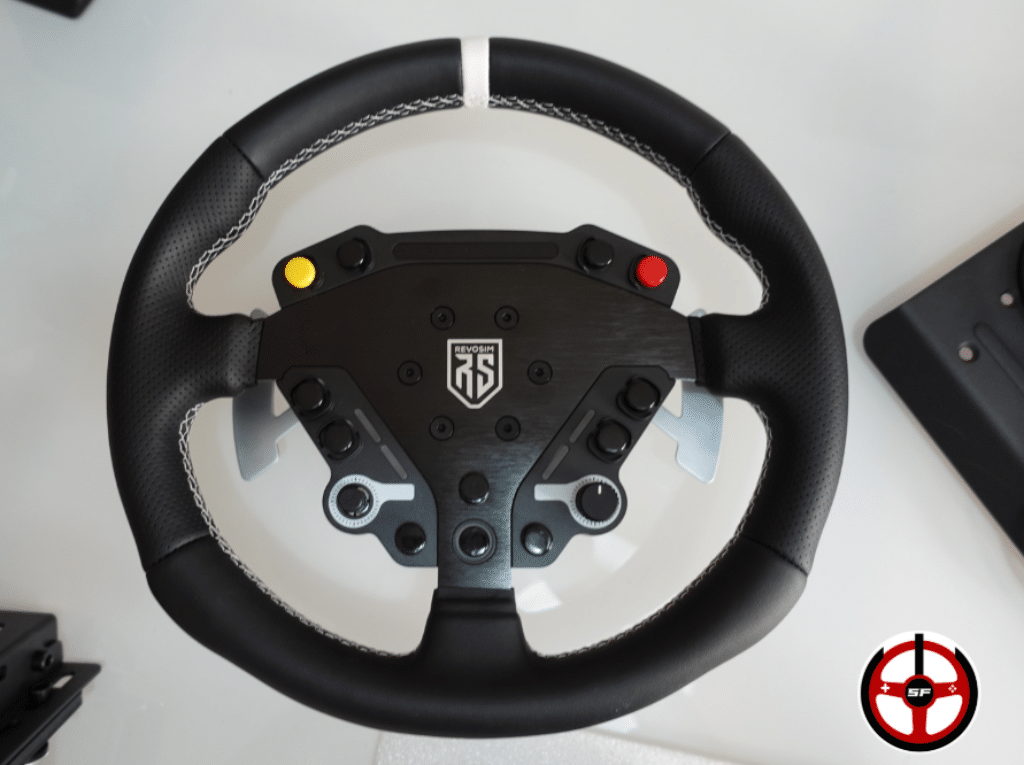
| Diameter of round hoop | 30cm, screwed onto the Hub to replace it with future Revosim models. |
| Materials | Aluminum, plastic |
| Grips | Stitched imitation leather. |
| Vibration | No |
| Paddles | 2 metal paddles for shifting (non-magnetic switches) |
| Paddle operating noise | 45dB |
| Customizable buttons | 11 buttons with customizable inserts, 1 button with LED ring, 1 clickable 2-position encoder, 1 7-position switch |
| LED display | 9 lap-count LEDs, 4 LEDs displaying selected mode 1 button with LED ring (not parameterizable at time of test) |
| Display | No |
| Quick Release | NRG-type Quick Release |
| Base compatibility | RevoSim |
| Options | Formula-type grip coming soon. |
| Steering wheel price only | 199,90€ |
So, how does the RS Pure steering wheel look?
The steering wheel hoop currently available is in imitation leather with white stitching on the inside of the wheel and stitched leather on the grips. The grip is pleasant, and the leather is slightly knurled, which I found very comfortable on long sessions.
The white stitching is well defined, at least on the steering wheel I received. So you won’t damage the threads with a fingernail during a turn. On the other hand, if it’s white, it’s bound to get dirty. A little brush to clean it once in a while won’t go amiss to keep it in perfect condition.
But… wait… You won’t have any problems with dirt, because with the code SAMETFLO you get a pair of gloves for free!
The buttons have a fairly light click (less than 200gr), very typical of video game controllers. They can be customized with different colored caps and stickers to modify the inscriptions.
9 LEDs let you follow the lap counter. The 4 LEDs at the bottom of the steering wheel indicate which FFB setting is active on the wheel. To switch from one mode to another, simply click on the rotary selector at the bottom right of the steering wheel.
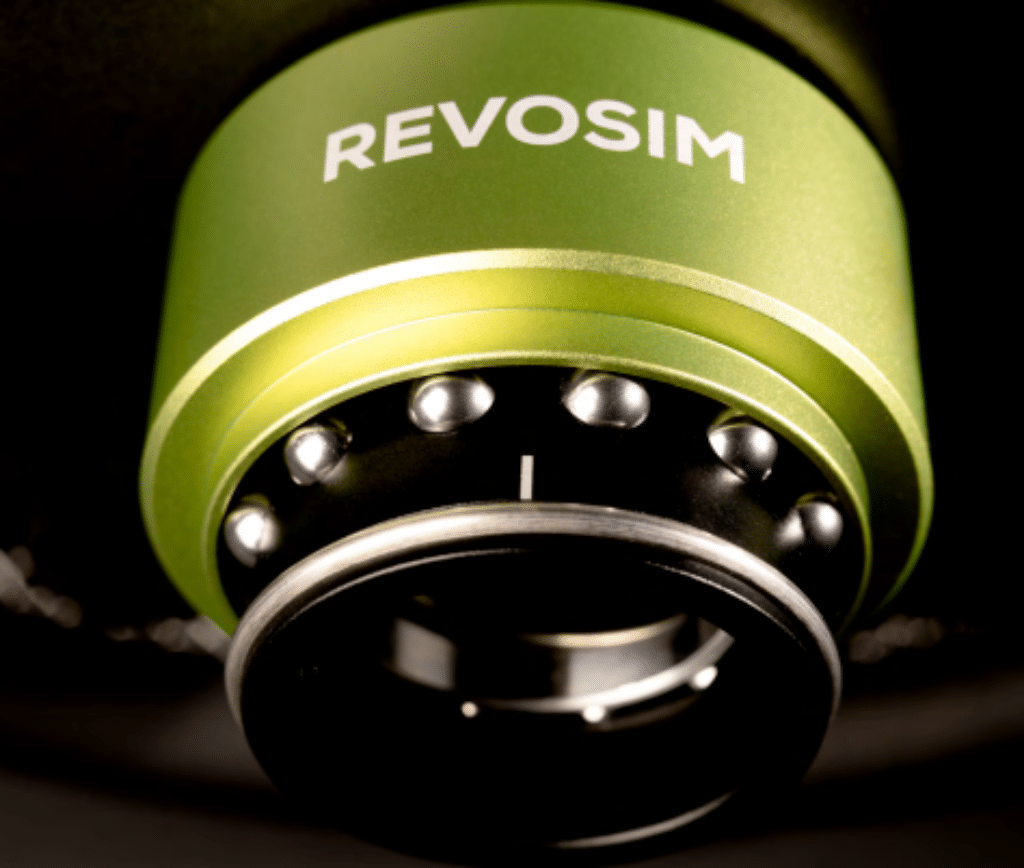
As for the Quick Release installed between the Hub and the base, it’s a Type NRG model (the same ones found on Simagic and Moza bases, among others). A system that has long since proved its worth. And the connections between the steering wheel and the base are spring-loaded pins to prevent breakage.
Note that the Hub alone is available on the Revosim website for 199.90€
Paddles that deserve to be tougher
While the steering wheel is generally very satisfying and ergonomic, the paddles won’t please everyone. As a reminder, there are 2 switch paddles (non-magnetic) at the rear of the steering wheel. They’re made of aluminum and sit comfortably under the fingers. Their click is really quiet, at just 45dB , but this silence comes with a drawback: they’re very light.
The click is not very clean. Only 430 grams on activation. And the paddle’s movement is short, so I occasionally clicked on it without wanting to. So you might say, “Sam, you shouldn’t let your fat fingers hang around on a palette when you don’t need them”. Yes, I agree. But the fact remains that paddles are the keys we’re going to use most on the steering wheel during races. And with a more direct click, we’d really have gained in driving pleasure.
Load Cell Revosim RS Pure pedalset
The architecture and materials are very reminiscent of those found on entry-level pedalboards from Fanatec, Moza or Thrustmaster, for example. But make no mistake: in terms of robustness and available settings, it’s something else entirely!
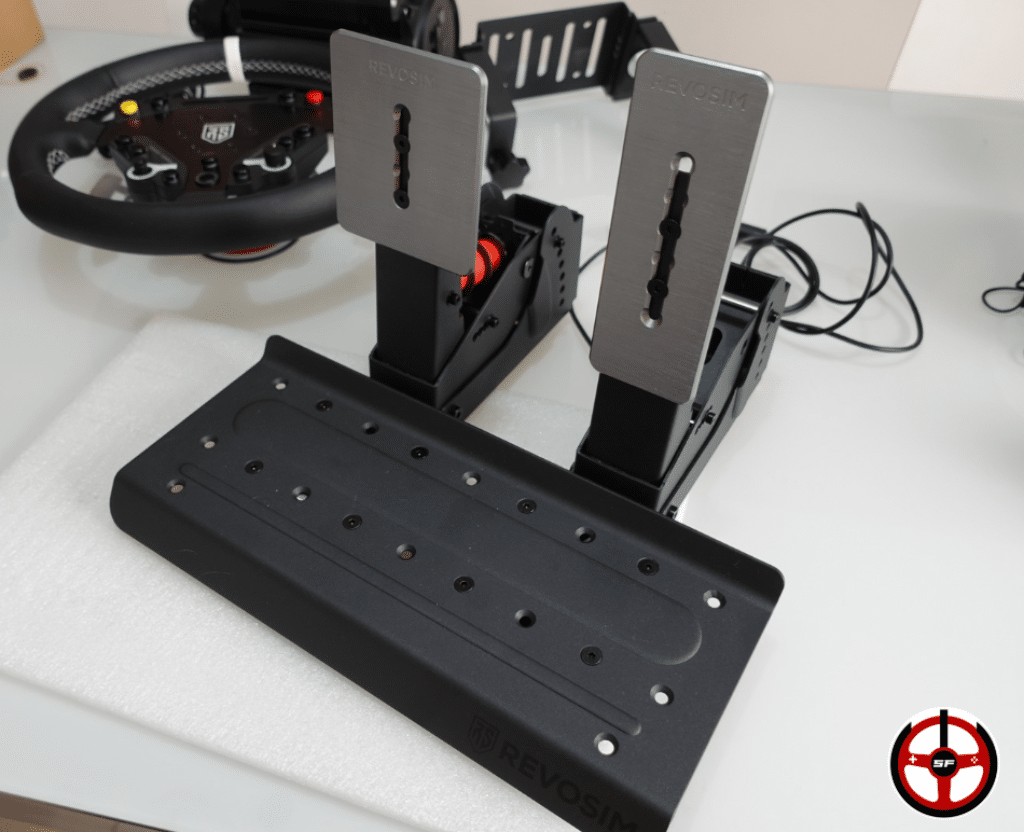
| Materials | Aluminum, steel |
| Pedals | 2 pedals (clutch option coming soon) |
| Throttle | Spring-loaded Magnetic Hall sensor NC resolution |
| Brake | Movement with interchangeable elastomers Rubber pads supplied : 9 rubbers with hardness ranging from 20 Shore A to 80 Shore A Load cell with 100Kg capacity |
| Vibrations | No |
| Connections | RJ45 to base or USB to PC |
| Options | Clutch pedal coming soon, Additional rubber kit to modify brake feel. |
| Price of pedalset alone | 149,90€ |
How do I install the pedalset?
If you’re riding with the pedalset on the ground, simply connect the pedals to each other and to the Direct Drive base. Then screw on the heel plate. Rubber pads are provided both under the pedals and at the rear to brace the pedalset against a wall.
On fixed frames, however, you’ll need a little patience. Don’t forget to plug in the pedals before fixing the pedalset to the frame! Otherwise you’ll have to remove at least the heel plate. Attachments to the frame are made via 2 screws at the front, which pass through the heel plate, and two screws at the rear of the pedals. But be careful, if you want to screw in the one at the rear of the brake pedal: you’ll first need to tilt the whole pedal forward by unscrewing the axle on which the rubber pads are mounted. Without this, access to the screw holes will be almost impossible.
And for the physical adjustments available on the pedalset, go here:
| Throttle | Pedal angle from 60 to 90°, Pad height over 3cm, Pedal position across the width, Limit stop. |
| Brake | Pedal angle from 60 to 90°, Brake pad height 1.5cm, Pedal location on width, Brake hardness with 3 types of rubber, Limit stop (Don’t touch it, it’s useless on a Load Cell unless you want an “indicator” when you’ve reached 100% braking) |
This pedalset is worth a look!
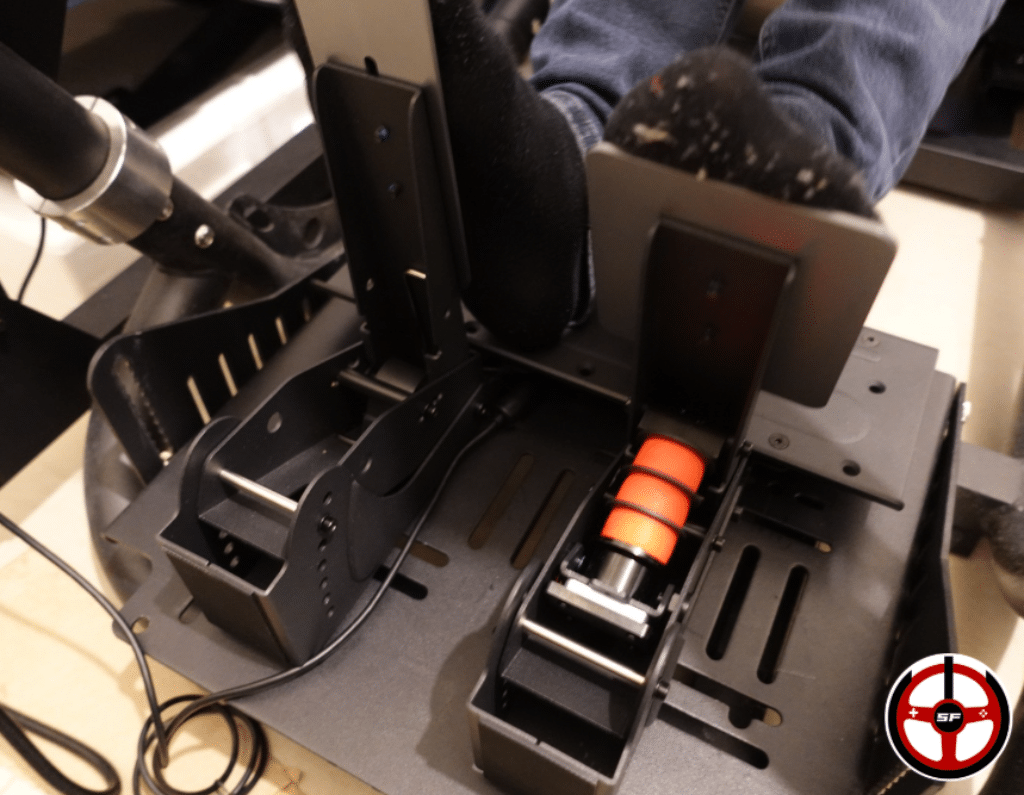
The trottle is very simple, with a spring-loaded movement and HALL-effect sensor, angle and stop adjustment. The brake, on the other hand, features an elastomer movement that can be changed to harden or soften the movement.
The pedalset comes with 3 sets of soft/medium/hard rubber, ranging in hardness from 20 Shore A to 80 Shore A. If you ride with the pedalset on the ground, you’ll prefer to use the soft rubbers, but on a chassis, I strongly advise you to give the yellow and red rubbers a chance – your lap times and muscle memory will thank you! A kit with other rubber compounds and possibly springs should follow, but no release date has yet been announced.
The brake sensor is a Load Cell (sensor of the force applied to the brake) with a capacity of 100Kg. We can also modulate our riding position with ease, thanks to the 7 available pedal angles ranging from 90° (vertical pedal) to 60° for use under a desk or on a sofa.
The height-adjustable foot plates are easily accessible, even for small feet. In the initial configuration, even Flo in size 35 was comfortable. As for me, with my size 43, I just needed to raise the pads up a notch.
In terms of fun on the track and raw performance, I quickly found I was happy with the red rubber and set times very close to my usual ones. Feeling on degressive braking is correct, even very good if you compare it to equivalent competitor models.
On the other hand, the throttle can be noisy if you “bang it” when the throttle is released. Watch out for angry spouses!

